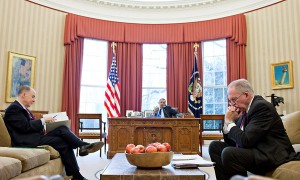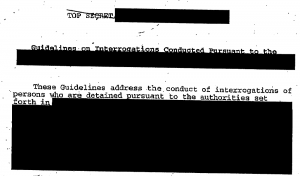Did Zero Dark Thirty Accidentally Tell the Most Dangerous Truth?
Update: Let me make this clear: I am not commenting on the content of the movie. I am commenting on the content of John Rizzo’s reactions to the movie, particularly his depiction about when and how and by whom “the box” was approved, which — as I say several times — get to the core of the legal problems with torture.
In a development I could have predicted, one of former CIA Acting General Counsel John Rizzo’s chief complaints with Zero Dark Thirty has to do with how the movie depicted “the box.” (This exchange comes from the first comments Rizzo made at an AEI event with him, Dick Cheney flack Marc Thiessen, former CIA Director Michael Hayden, and the director of the torture program, Jose Rodriguez).
MR. RIZZO: The interrogation scenes – I mean, they were – they were striking. They were hard to watch for me, having lived through this and how the – how the actual techniques came to be, and all the safeguards we put on them, all the monitoring by medical personnel during the course of the interrogation – you know, again, it’s a movie, so you know, the character in the movie, the interrogator, seemingly making stuff up as you went along, you’re not talking – OK, bring on the water and –
MR. : (Off mic) – get the buckets.
MR. RIZZO: – and get the buckets – now, the box – people have asked me about the box. And since this whole thing has been declassified now, most of you probably know that one of the techniques was a box, putting a detainee in a box for a – for a limited duration. Now, the box in the movie is not the kind of box that was – that was used. When I say all this, I don’t want to downplay or leave any impression that the actual program, the actual – the actual waterboarding was, you know, was tame or benign. I mean, it was a very aggressive technique, as were all the – all the others. But – so on the whole, I mean, I went into it – I went into it telling myself it was going to be a movie. I was frankly relieved that there were no lawyers involved in the movie. (Laughter.) I would have just spent the next four years at cocktail parties explaining why I wasn’t that lawyer. So I was – so I mean, on the whole, it’s as they said. It was a mixed bag, but it was a terrific movie. And you know, I think it did really take no sides and Miss Bigelow and Mr. Boal, I think, skillfully teed up the complicated moral questions of all of this we’re facing, especially in those first few scary months after the 9/11 attacks.
MR. THIESSEN: Can I – just to follow up on that. I mean, you know, you were the chief legal officer at the time. I mean, would you have authorized the interrogation techniques the way they were depicted? I mean, explain the difference in the box – (chuckles) – explain the – you know, explain that you – do people just throw somebody on a mat and start pouring water over their heads? I mean –
MR. RIZZO: No, no, the – first of all, you know, it was – it was “Mother, May I.” Those interrogators were not allowed to adlib. There were certain specific –as the memos – OLC memos show at the time, I mean, it was a – there was a meticulous procedure to undertake. And before the use of the waterboard – they will confirm this – the interrogators at the site would have to come back in writing, explain why they thought the waterboard was necessary, it would be approved at headquarters. During the time the waterboard was used, which was only until mid-2003, it took the CIA director to approve the use. So it was a much more modern program. Now, the box – I mean, a box is not pleasant. First of all, there is – there was a big box authorized that the detainee could stand in and a smaller box. It wasn’t – it didn’t appear to me to be quite as small as what was depicted in the movie. But yes, there was a box technique. But again, the – I mean, when I – you know, everyone can look at this in a different way. I just had the impression from the scene that the guy was sort of, you know adlibbing as he went along, which was, believe me, far from the – far from the reality. [my emphasis]
The box — particularly the apparent portrayal (I haven’t yet seen the movie) that the torturer ad-libbed when he introduced the box — is as big a concern of Rizzo’s as waterboarding is.
Of course it is.
That’s because the coffin — later dubbed a small box to give it legal cover — used to conduct a mock burial with Abu Zubaydah is the at the heart of the legal problems with torture.
As these posts lay out (one, two, three, four), one of several main reasons CIA asked the Office of Legal Counsel for a memo authorizing torture is because Ali Soufan saw Abu Zubaydah’s torturers prepare to put Abu Zubaydah in a coffin (it’s unclear whether he or his partner Steve Gaudin saw them actually use the coffin). That is one of the things — perhaps the thing — that Soufan labeled “borderline torture.” And because an FBI officer had told CIA’s contractors he might need to prosecute them for what he had seen, CIA needed more durable legal cover than the daily approvals given by Alberto Gonzales every night.
Because an FBI officer had labeled the things approved by the White House, on the President’s authority, illegal.
Which is why John Rizzo and John Yoo started writing first the July 13, 2002 memo generally authorizing torture (this memo is what the CIA would ultimately rely on to claim things like the murder of Gul Rahman were legal) and then, several weeks later, the Bybee Memo laying out the approved torture techniques in detail.
John Rizzo tried to get John Yoo to approve the technique that had already been used on Abu Zubaydah, the one Ali Soufan had labeled illegal. He tried to get mock burial approved as a technique; he kept trying right up until the last days before the Bybee Memo was finalized. But for some reason — I suspect, because Michael Chertoff had already agreed with the FBI that the mock burial Ali Soufan complained about was illegal — it was not included in the final list.
Instead, John Yoo and Jay Bybee approved “small box confinement.” Something that, if everyone remained silent about the intent and desired effect of shoving someone in a coffin-shaped box and leading them to believe they’d be buried alive, would both retroactively approve the use of a coffin that Abu Zubadayh’s (and Ibn Sheikh al-Libi’s) torturers had already used, but also let them use mock burial in the future, in spite of the fact that John Yoo — even John Yoo — had deemed it illegal.
One of the main things an FBI officer judged illegal — mock burial, a technique that had already been used, on the authority of the President — is the only single torture technique John Yoo ever deemed illegal.
Again, I have not yet paid to see the CIA’s propaganda effort. But John Rizzo, at least — the man who tried so hard to get the OLC to approve mock burial — is very concerned both about the size of the box in question (the SERE document used to label it “small box confinement” prescribed size and time limits), but more importantly that torturer in the movie is depicted as using the coffin-shaped box without first getting approval for it.
The movie, it seems, shows a torturer using a coffin before John Yoo and John Rizzo would have deliberated for weeks and decided to call it small box confinement. The movie, it seems, shows a torturer using a coffin to conduct a mock burial [Update: I’ve been told they don’t do a burial in the movie, though it does depict adlib], and doing so in terms that make it clear that the coffin preceded the DOJ approval for it.
I’m extrapolating from Rizzo’s comments, but it seems likely that his problem with the box is that ZD30 depicts its use in precisely the terms that make it illegal, the one act of torture labeled illegal as it was happening, one of the main acts of torture the OLC memos were designed to provide legal cover for.
Frankly, I’m sympathetic to Rizzo’s complaint that this depiction of a torturer ad-libbing by using a coffin is inaccurate (though not to his claim that it was an OLC memo that limited the torture). After all, we know that the White House was responding to the torturers’ “Mother, May I” on a daily or near-daily basis.
We know that the White House was renewing its Gloves Come Off Memorandum of Notification approval for things like mock burial at each step of the process. So it’s not like the torturers executed a mock burial without approval.
The problem, however, is that they executed a mock burial with the President’s approval, weeks and months before the DOJ would deem that one torture technique illegal.


